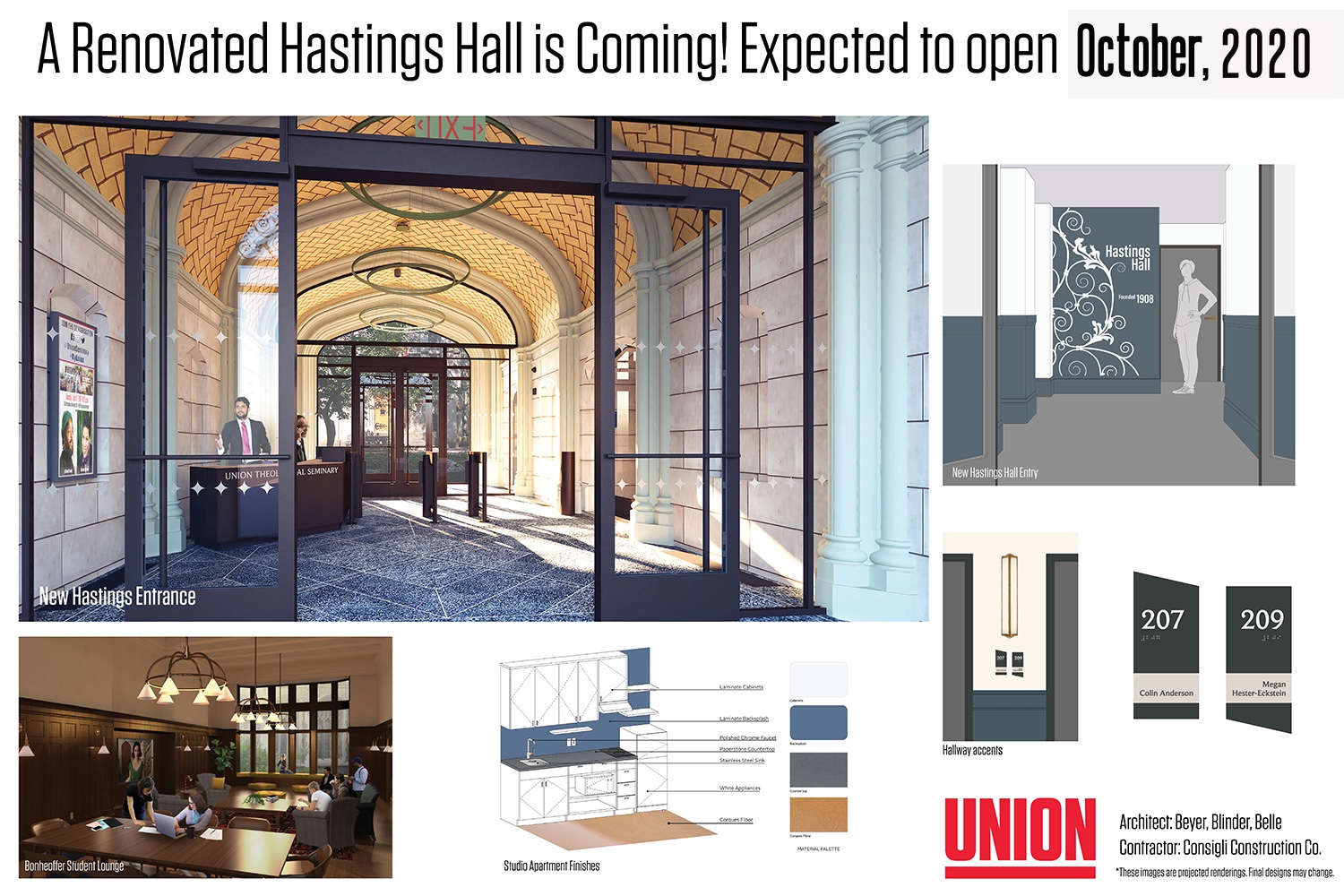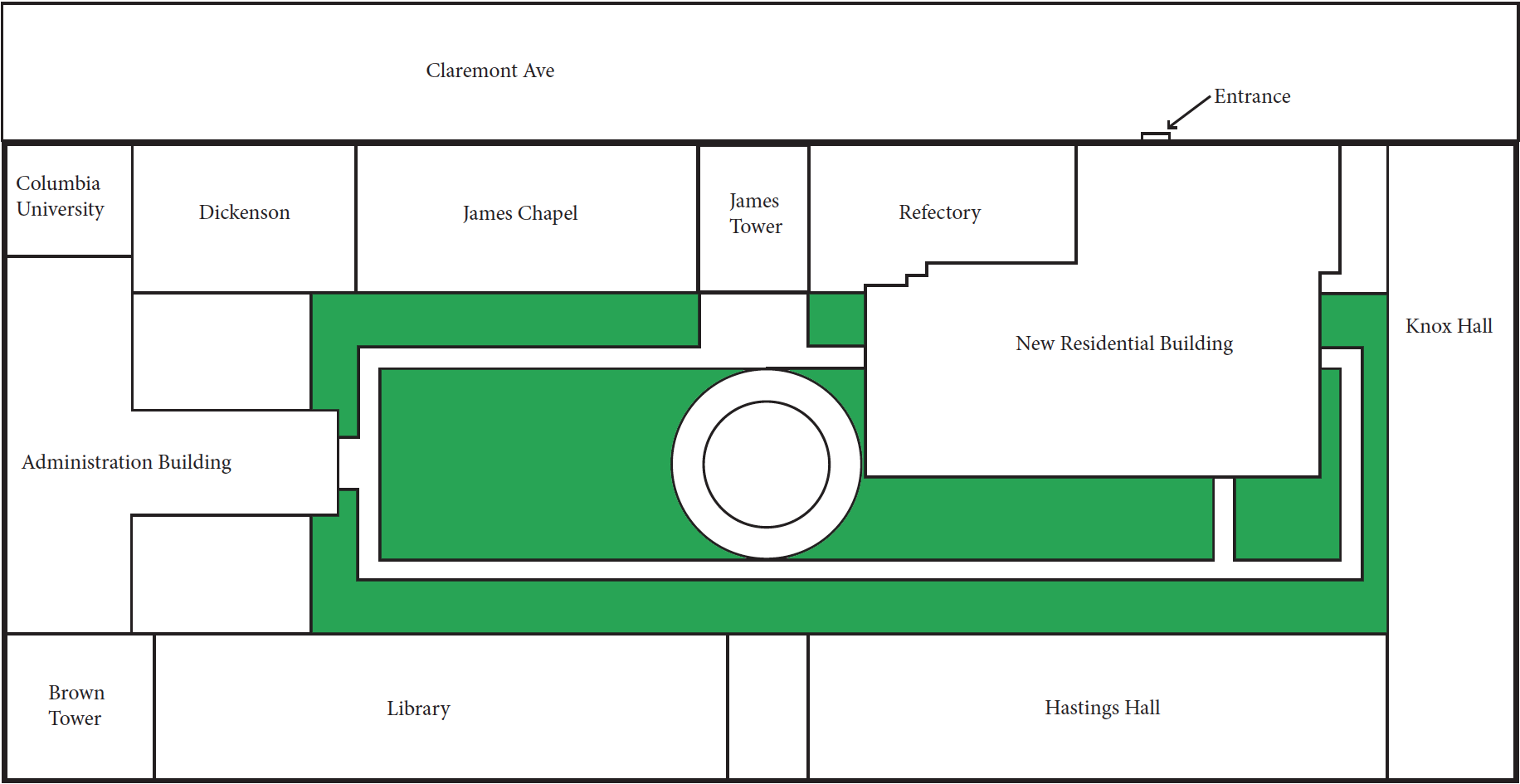
Status of Union's Campus Renewal Plan
December 4, 2018: Union announces community investment initiative
Release: Union Theological Seminary joins with Morningside Heights Community Coalition and P.A.’L.A.N.T.E to Protect and Support Vulnerable New Yorkers. Read the full statement here.
November 2, 2018: FAQs
You can find a list of frequently asked questions and their answers here.
August 21, 2018: Initial campus changes for fall 2018
Welcome and welcome back to all of you for what promises to be another exciting and eventful year at Union, and one that will hopefully bring our community closer together as we embark on a series of projects to improve life on campus. As many of you know from last year’s town halls, this academic year will witness the beginning of a new construction project in the northern part of Union’s quad that will provide new classroom space, EDS at Union offices and faculty housing. In addition, we will begin preparations for a holistic renovation of our existing aging facilities.
After the multi-year effort, the newly renovated campus will offer improved accessibility wherever feasible, greatly improved sustainability, additional dedicated space for student lounges & communal areas, modernized classrooms, better multi-religious worship space, and a newly renovated Hastings Hall. This work will be done in two phases, with Hastings Hall being the first renovation project. The other areas will happen during phase 2, and will also include a complete overhaul of our mechanical and electrical systems to provide better temperature control on campus, and improve WiFi throughout the building.
We’re excited to share information with you about the changes that will improve the education and living accommodations for Union students in the decades to come. With preparation for construction getting underway, some areas of campus will no longer be accessible. Here is a summary of the initial changes for you to be aware of:
- The computer lab has been moved to AD10.
- Pub will be held in the Bonhoeffer Room this year, starting September 6.
- As of November 1, Lampman Chapel will be closed. We will be using AD 34 as a small chapel space beginning in the spring semester.
- As of December 1, the Refectory and Social Hall will be offline. Activities needing event space should consider James Chapel, Stewart Room, or Classroom 207 as alternate locations. With fewer large venue spaces available, early scheduling and flexibility will be key.
- Hastings Hall will be open through the end of this academic year. Next summer, Hastings will close and be under construction until the summer of 2020. Some additional housing for students will be available in McGiffert for 2019-2020 academic year and the administration is also looking into possible accommodations at nearby institutions. The newly renovated Hastings is expected to open in fall 2020.
- Access to the Quad will likely be impacted at the beginning of the spring 2019 semester.
We understand that these projects will impact student and campus life and we will keep you informed throughout the process via emails and the webpage dedicated to these projects, which can be accessed here. Information about 2019-2020 housing options will be shared by December 1.
In an effort to answer your initial questions about impacted spaces, and program relocation plans, we will host a town hall in September. At that time, we will have a preview of the Hastings renovation to share. Until then, you may direct your questions to Ben Perry, Deputy Director of Communications, at [email protected].
Thank you for your understanding and cooperation.
-Serene
July 13, 2018: Sale of McGiffert
The Riverside Church and Union Theological Seminary reach agreement on sale of McGiffert Hall
NEW YORK – The Riverside Church in the City of New York (Riverside) has agreed to purchase McGiffert Hall from Union Theological Seminary in the City of New York (Union). McGiffert Hall, located on the same block as Riverside at Claremont Avenue and West 122nd Street in Morningside Heights, is a gothic-style building currently being used by Union as residential housing for faculty and students.
The sale of McGiffert was initiated by Union as part of a larger campus renewal plan to make significant repairs and upgrades to the 108-year old campus. This transaction provides a portion of the critical funding needed to fix and replace the failing infrastructure, along with significant improvements to make Union more accessible and to better serve future generations of students. The property was subject to a right of first offer to Riverside and the church leadership elected purchase as part of its own sustainability efforts.
“It was Riverside and Union’s shared mission and values which led John D. Rockefeller, Jr to originally deed the land for McGiffert to Union for their faculty housing. We are pleased to now be able to purchase it back,” said Rev. Dr. Amy Butler, Senior Minister of Riverside. “This opportunity will provide for the long-term health of both institutions, enabling us to continue our work of proclaiming the gospel, fighting for social justice, and building beloved community.”
“We are pleased to have reached an agreement with Riverside, an institution that Union has had ties to for nearly 90 years,” said Rev. Dr. Serene Jones, President of Union. “This sale will help us make crucial upgrades to our campus and provide more accessible access to our campus for our students and the community who visit Union.”
As part of the purchase agreement, Union will lease back the property for up to five years while a new building is under construction on the campus that will contain new housing. During that time Riverside will engage in conversation with community partners and research entrepreneurial and innovative opportunities for the property with the intention that it will be used to meet the needs of both the church and wider community. The deal is expected to be finalized in September.
Updated: September 27, 2017
I write to share with you an update on the historic renovation of Union’s campus that is currently underway. The overarching goal of these renovations is to ensure that Union flourishes well into the future so our beloved Seminary can continue to provide academically superb and socially engaged theological education for new generations of students.
Union’s Board of Trustees began working on this comprehensive plan almost seven years ago. The buildings presently occupied by Union were built in 1907 out of Manhattan schist quarried on site. Still today, its neogothic classic design delights those who live on campus, as well as our valued neighborhood residents and visitors.
Maintaining these beautiful yet increasingly out-of-date structures, however, has been a struggle. Each year, new repairs have been required, and the list of expensive renovations has grown steadily. Responding to these needs, in 2010 the Board decided to stop addressing them in a short-term, and ultimately futile, piecemeal manner — which was draining Seminary resources meant for critical educational purposes — and instead to develop a comprehensive plan to address all maintenance needs. Throughout we have been committed to creating a visionary, mission-driven restoration of the whole campus. Our goal has never been to make a profit, but to fund the critically needed restoration of the buildings.
The most immediate need was stabilizing the schist facades in order for Union’s buildings to be safe and to allow UTS to remove a citation for loose stones issued by the New York City Department of Buildings. In addition to the work needed on the facades, comprehensive inspections of the buildings revealed that the plumbing, heating, and electrical infrastructure was antiquated and had deteriorated to a degree that made further repairs impossible. It also became clear that Union’s multi-level campus is inaccessible and unwelcoming to many in the community as well as visitors, and that our inefficient energy systems do not reflect a commitment to environmental sustainability.
In order to address these wide-ranging and systemic needs, the Board established a Facilities Planning Committee. This Committee has met numerous times over the last seven years, and we are thankful for their insight and direction. This committee determined that, at a minimum, addressing just basic needs would invoke staggering costs of more than $100 million. This led the Board to consider numerous alternatives, including moving the Seminary outside of Morningside Heights; turning Union into a non-residential school or think tank; closing the seminary; or partnering with another institution in the neighborhood. In the end, after exhaustive analysis with the help of superb consultants, it was decided that staying in our present location and undertaking a total renovation on site was by far the best option, both educationally and financially.
The Facilities Committee also explored numerous models for funding the project. Because the UTS endowment supports basic operations and student scholarships, both essential to the mission of the Seminary, it was decided to not fund the renovations out of the endowment. The Board also retained consultants to evaluate whether the necessary funds could be raised. They learned that while Union has strong support from many friends and alumni/ae, the needed resources exceeded the current capacity of our donor base.
New Residential Building
Without endowment funds and without the realistic assurance that funds could be raised, it was decided that the only way to renovate Union’s cherished buildings, and secure Union’s future, was to sell our “vertical real estate,” known in New York City as “air rights.” The process of choosing the buyer for these air-rights was extensive and conducted with great care and sensitivity, taking into account not only Union’s immediate needs but also the Seminary’s social and theological commitments. With these practical and lofty guiding intentions, UTS chose to contract with the development company L & M Partners, to buy the Seminary’s air rights and to build a new private residential, market-rate building on the northwest quadrant of the courtyard. UTS has purchased eight floors in the base of the new structure to house UTS faculty and to provide space for the Episcopal Divinity School, which in a historic decision has decided to affilitiate with Union. There are no architectural drawings yet for the new building but we do have the basic footprint, which we will post to Union’s website.
From the beginning of our planning for the total renovation and redesign of Union’s physical space, the Seminary leadership has been determined to include a component that would address the serious poverty-rate housing crisis in New York. As a concrete expression of this commitment, UTS and L & M decided to set aside funds from the project to support wide-ranging advocacy and action related to this issue. This “housing project” is still in its infancy, and we look forward to sharing more details as they develop and to getting the whole community’s input into how we best deploy these resources. Our decision to set aside substantial funding for community engagement around housing is unprecedented in New York City projects like ours and is already being lifted up as a model of socially engaged development.
Campus Renewal
As the Board had planned, the sale of Union’s air rights generated sufficient funds to begin a comprehensive renovation and redesign of our campus. To lead us through this complex process and aid in developing the design, the Board chose the architectural firm of Beyer Blinder Belle (BBB), who will be soliciting input this fall from the entire Union community regarding our present and future needs. Specific projects have yet to be determined, but we anticipate that student housing, classrooms, worship, faculty and administrative offices, and general community and meeting spaces on campus will have high priority.
As plans for the construction phase of these projects become available, we will share them with you.
Further Questions?
Ben Perry, UTS ’16, Union’s assistant director of communications and marketing, will be serving as the contact person for all members of the community who have questions or concerns about the project, including everything from details about construction to broader concerns about community impact. He can be reached at 212-280-1591 or [email protected]. Or, just stop by his office in AD 125. This week, we will also be including on Union’s website a list of questions that I have been asked about the project, along with hopefully helpful answers.
Please join me at two upcoming town hall meetings scheduled Thursday, September 28th from 12:30 to 1:30 in the Social Hall, and the following Thursday, October 5th from 12:30 to 1:45 in the Stewart Room. At the first town hall we will answer any questions you have about the overall scope of Union’s campus renovation. At the second, we will ask for student input for our campus redesign.
I look forward to your engagement as we together create a compassionate and reimagined Union for future generations.
Peace,
President Serene Jones
Updated: June 15, 2017
As Union moves into this time of transition and significant change, it is important to remember that as an academic institution, Union is presently in a strong position, both financially and programmatically. We have a healthy endowment, a balanced operating budget, a growing student body, and a strong faculty. Moreover, we are leading the way in the “reinvention” of theological education with our new programs in interfaith engagement and strong public and global theology. That said, it is also the case that our long-term future is threatened unless we address the state of our 108-year-old facilities and create a viable plan for campus renovations.
As previous sections have explained in detail, the Board and senior administration are very concerned about these issues. The cost to renovate and maintain city regulatory compliance of our buildings, three of which are designated landmarks, is estimated at over $100 million. This enormous expense will only dramatically grow as our buildings continue to age and require restoration. The scaffolding now surrounding portions of our exterior wall testifies loudly to this need. On a daily basis, those on campus must deal with limitations and obstacles produced by our deteriorating buildings.
Right now, the expense of maintaining Union’s campus on a piecemeal basis is draining important funds that should be used to support our primary educational mission. Without a bold yet practical plan to renovate Union’s campus, it is clear to the Board that the seminary will be unable to fulfill its educational and social mission in the years ahead.
In response to this, the Board and senior managers have come to realize that the seminary must use every tool at its disposal to generate these essential funds. To garner the bulk of these funds, the seminary plans to sell Union’s development air rights (Under New York zoning laws, development rights are vertical zoning rights that, like land, can be monetized) and explore transactions related to McGiffert Hall. These two transactions will allow us to maintain a fully residential campus and to continue expanding our educational mission at the exciting pace it is currently moving. Development rights are determined by a Floor Area Ratio (FAR) calculation.
What does this mean concretely? Utilizing the development air rights, Union will work with a developer to create an appealing, slender building that is visually in keeping with the neighborhood, set on the north end of the quad. This location was chosen after thorough analyses showed that this was the best suitable site. Our intent is that our newest building will feel, architecturally, as if it has always been part of the campus. Regarding height and design, the tower will be approximately the same height as, but stay in respectful dialogue with, the tower of The Riverside Church, our closest neighbor.
It is important to note that this plan allows us to continue Union’s commitment to providing affordable housing for a significant proportion of our students. While living on campus is not a required part of the academic experience, it is an available option that makes possible distinctive forms of community and learning. Moreover, historically, our faculty has lived on campus as a part of our commitment to creating a communal learning environment. Both of these housing needs–student and faculty–will be amply provided for in the new plan.
This facilities plan, if it advances, requires that a portion of land inside the north section of our campus be sold to a developer, along with its air rights. The developer will then build the apartment house, and sell private units above the eighth floor. As the proposal now stands, Union would own and control all the apartments on the bottom eight floors of the building, housing our faculty and providing rooms for guests and visiting scholars and friends.
The Board is committed to maintaining the close residential feeling of the campus and will assure that the upper-level apartments do not have access to the main campus, our quadrangle, classrooms, dormitories and shared community spaces. We will construct an open cloister that wraps around the southern half of the quadrangle, completing the original vision of the campus’s 1908 architects. In order to maintain the integrity of our educational space, the upper-floor, private residents will enter the upper building from an entrance on Claremont.
We do not yet have advanced models of the building to share with you but will do so as they become available. As to what the interior of the renovated campus will look like, we look forward to engaging the whole community in creative and wide-range conversations about our needs and possibilities. This includes trying to imagine what a seminarian in 2066 might want in a building that houses the study of theology, ethics, religion, scriptures, activism, philosophy and the many ways we reflect, as humans, on the meaning of our lives.
The Board and senior managers remain optimistic about the comprehensive, proactive, and practical plan that has been developed because it will achieve many institutional goals that matter to the entire Union community.
New residential building footprint

